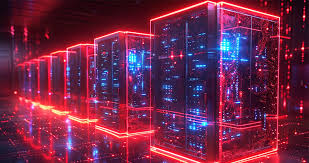GPU Clusters at Scale are transforming the way organizations process massive datasets, train sophisticated AI models, and deliver high-performance computational tasks faster than ever before. By harnessing hundreds or thousands of GPUs working in parallel, enterprises can unlock unprecedented levels of productivity across data science, deep learning, analytics, and simulation workloads. As industries demand more computational power, the ability to scale GPU clusters efficiently has become a critical factor for staying competitive.
Why GPU Clusters Are Essential for Modern Workloads
GPU clusters accelerate machine learning and AI workloads by enabling parallel processing far beyond what CPU-only systems can handle. They are the backbone of industries like:
- Healthcare for medical imaging and drug discovery.
- Finance for predictive modeling and fraud detection.
- Entertainment for rendering complex animations and simulations.
- Research for high-resolution weather modeling and genome analysis.
When scaled strategically, these clusters form the infrastructure for innovation, allowing work that once took months to be completed in days or even hours.
Core Benefits of Operating GPU Clusters at Scale
- Massive Computational Power: Organizations can process petabytes of data efficiently.
- Reduced Training Time: Machine learning models reach deployment readiness faster.
- Flexibility: Resources can be allocated dynamically based on workload needs.
- Cost-Effectiveness: Shared GPU resources avoid idle infrastructure costs.
Challenges in Scaling GPU Clusters
While the potential is immense, scaling GPU clusters is not without challenges:
- Network Bottlenecks: High-speed interconnects are vital to prevent processing delays.
- Load Balancing: Efficient workload distribution ensures optimal utilization.
- Energy Management: Large clusters consume significant power.
- System Integration: Merging GPU infrastructure with existing IT ecosystems takes careful planning.
This is where expert guidance plays an essential role. Companies integrating GPU clusters often partner with specialists—such as those offering managed IT services Dallas—to ensure seamless deployment, monitoring, and optimization. This not only maximizes performance but also eliminates operational headaches.
Best Practices for Deploying GPU Clusters at Scale
- Assess Workload Requirements: Identify the compute and memory needs before investing.
- Leverage Containerization: Use Kubernetes or similar tools to streamline workload distribution.
- Prioritize Network Architecture: Choose low-latency, high-bandwidth connections between nodes.
- Optimize for Energy Efficiency: Reduce heat output and power draw with modern cooling solutions.
- Implement Monitoring Systems: Track GPU health, utilization, and performance metrics in real time.
Case Study: AI in Large-Scale Retail
A global retail corporation deployed GPU clusters at scale to process vast amounts of customer data for real-time personalization. By reducing model training from weeks to hours, they achieved higher conversion rates and improved customer experiences. Scalable architecture allowed them to handle seasonal spikes without infrastructure strain.
The Future of GPU Cluster Scaling
As AI and automation continue to drive digital transformation, GPU clusters will evolve further with:
- Next-gen GPUs offering higher core counts and memory capacity.
- Integration of Quantum Accelerators for hybrid computing workflows.
- Smarter orchestration systems that leverage AI to optimize workloads without manual intervention.
Enterprises that act now to build flexible, scalable GPU infrastructure will be positioned at the forefront of innovation, able to adapt to whatever computational challenges the future brings.







